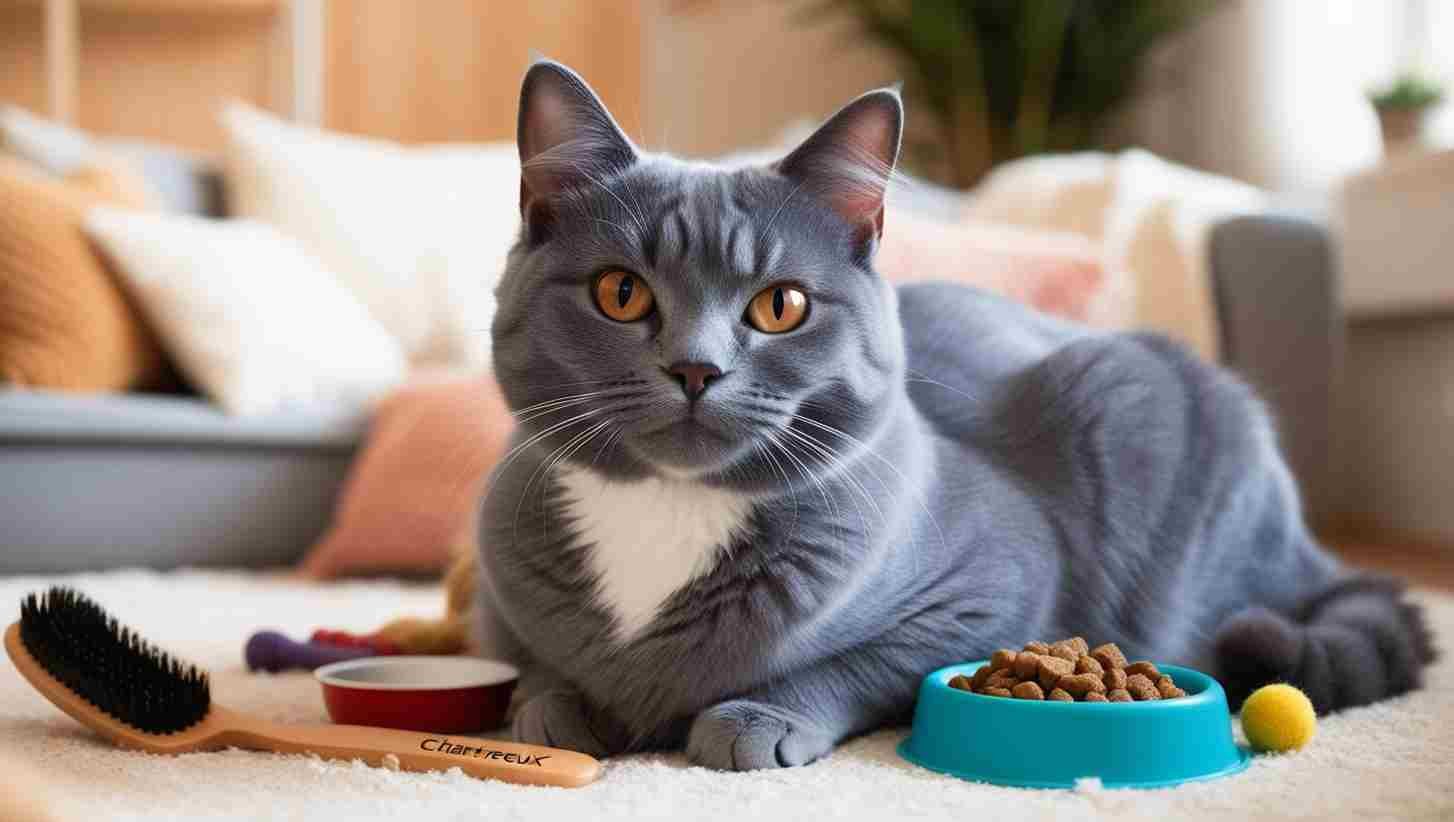Chartreux Cat Care: Essential Tips for a Happy, Healthy Cat
The Chartreux cat, with its stunning blue-gray coat and gentle, affectionate nature, is a breed that captivates cat lovers worldwide. Originating from France, these cats are not only beautiful but also known for their intelligence and calm demeanor. However, providing the best care for a Chartreux requires understanding their unique needs, from grooming and diet to health and behavior. This guide is your ultimate resource for Chartreux cat care, offering practical tips, expert advice and answers to common questions to ensure your feline companion thrives.
Chartreux cats are relatively low-maintenance but still require a structured routine and proper care to stay healthy and happy. Whether you’re a first-time owner or an experienced cat parent, this article covers everything you need to know, including daily care routines, grooming techniques, dietary recommendations and how to address common health concerns. You’ll also find tips on training, socialization and creating a stimulating environment for your Chartreux. By the end of this guide, you’ll feel confident in your ability to provide the best chartreux cat care for your furry friend.
Summary of the Article
- Understanding the Chartreux Cat: Learn about their size, coat, personality and lifespan.
- General Care Tips: Daily routines, essential items and beginner-friendly advice.
- Health and Wellness: Common health issues, vaccinations and senior care tips.
- Grooming and Maintenance: Brushing, bathing, dental care and nail trimming.
- Diet and Nutrition: Feeding schedules, food types and weight management.
- Behavior and Training: Socialization, litter training and playtime ideas.
- Exercise and Activity: Keeping your Chartreux active and engaged.
- Adoption and Ownership: Tips for adopting and caring for a Chartreux.
Understanding the Chartreux Cat
The Chartreux is a medium-sized cat with a muscular build and a dense, water-resistant coat. Their copper or gold eyes and smiling expression make them irresistible. Known for their quiet and gentle nature, Chartreux cats are great companions for families, singles and seniors alike.
Key Points:
- Size: Medium-sized, weighing between 7-16 pounds.
- Coat: Blue-gray, dense and water-resistant.
- Personality: Calm, affectionate and intelligent.
- Lifespan: 12-15 years on average.
- Rarity: Considered a rare breed, especially outside France.
Chartreux cats are low-maintenance but thrive on love and attention. Their unique traits make them a joy to care for, but understanding their needs is essential.
General Chartreux Cat Care Tips
Caring for a Chartreux cat involves creating a consistent routine and providing the right environment to ensure their well-being. These cats are highly adaptable but thrive on structure, making it essential to establish a daily schedule for feeding, playtime and grooming. By understanding their unique needs and preferences, you can provide the best Chartreux cat care and keep your feline companion happy, healthy and content.
Key Points:
- Daily Routine: Set feeding, playtime and grooming schedules.
- Essentials: Provide high-quality food, a clean litter box and interactive toys.
- Beginner Tips: Start with a kitten-proof home and gradual introductions.
- Checklist: Use a care checklist to stay organized.
- Home Preparation: Create safe spaces and scratching posts.
A well-structured routine ensures your Chartreux feels secure and happy.
Health and Wellness
Chartreux cats are generally healthy but can be prone to certain health issues, such as dental problems, obesity and hip dysplasia. Regular vet check-ups and preventive care, including vaccinations and weight management, are crucial for maintaining their well-being. By staying proactive with their health, you can ensure your Chartreux cat care enjoys a long, happy life as part of your family.
Key Points:
- Common Health Issues: Dental problems, obesity and hip dysplasia.
- Vaccinations: Follow a vet-recommended vaccination schedule.
- Senior Care: Monitor weight, joint health and activity levels in older cats.
- Weight Management: Avoid overfeeding and provide regular exercise.
- Signs of Illness: Look for changes in appetite, behavior or litter box habits.
Proactive care can help your Chartreux live a long and healthy life.
Grooming and Maintenance
The Chartreux’s dense, water-resistant coat requires regular grooming to keep it in top condition and prevent matting or excessive shedding. While they are not high-maintenance, brushing their coat 2-3 times a week and occasional bathing can go a long way in maintaining their sleek appearance. Additionally, don’t forget to trim their nails, clean their ears and brush their teeth as part of a complete Chartreux cat care routine.
Key Points:
- Brushing: Brush 2-3 times a week to reduce shedding and prevent mats.
- Bathing: Bathe only when necessary, as their coat is water-resistant.
- Dental Care: Brush teeth weekly to prevent dental issues.
- Nail Trimming: Trim nails every 2-3 weeks.
- Hypoallergenic: While no cat is truly hypoallergenic, Chartreux cats shed less than many breeds.
Regular grooming keeps your Chartreux looking and feeling their best.
Diet and Nutrition
A balanced diet is essential for your Chartreux’s overall health and well-being. These cats have specific nutritional needs that vary depending on their age, activity level and health status. Providing high-quality wet or dry food, portion control and avoiding toxic foods like chocolate or onions are key aspects of Chartreux cat care. By meeting their dietary requirements, you can ensure your Chartreux stays energetic, healthy and happy throughout their life.
Key Points:
- Feeding Schedule: Feed 2-3 small meals daily.
- Food Types: High-quality wet or dry food or a mix of both.
- Portion Control: Avoid overfeeding to prevent obesity.
- Toxic Foods: Avoid chocolate, onions and grapes.
- Hydration: Ensure fresh water is always available.
A proper diet supports your Chartreux’s energy levels and overall health.
Behavior and Training
Chartreux cats are highly intelligent and respond well to training, making them a joy to teach new tricks or commands. Their calm and affectionate demeanor also makes them easy to socialize, whether with people, children or other pets. Incorporating positive reinforcement, interactive play and consistent routines into your Chartreux cat care plan will help them adapt seamlessly to your household and strengthen your bond with them.
Key Points:
- Socialization: Introduce them to new people and pets gradually.
- Litter Training: Most Chartreux cats learn quickly with a clean, accessible litter box.
- Playtime: Use interactive toys to keep them mentally stimulated.
- Behavioral Issues: Address scratching or biting with positive reinforcement.
- Training: Teach basic commands and tricks using treats and praise.
With patience and consistency, your Chartreux will be a well-behaved companion.
Exercise and Activity
While Chartreux cats are not overly active, they still enjoy playtime and mental stimulation to keep them engaged and happy. Regular interactive play sessions with toys, climbing trees or puzzle feeders can prevent boredom and promote their physical health. Incorporating these activities into your Chartreux cat care routine ensures they stay fit, mentally sharp and content in their indoor environment.
Key Points:
- Playtime: Spend 15-20 minutes daily playing with toys.
- Indoor Activities: Provide climbing trees and scratching posts.
- Outdoor Safety: Supervise outdoor time or use a secure enclosure.
- Exercise Needs: Moderate activity is sufficient for this breed.
- Toys: Use puzzle toys to challenge their intelligence.
Regular playtime keeps your Chartreux happy and healthy.
Adoption and Ownership
Adopting a Chartreux cat is a rewarding experience but it’s important to be well-prepared to meet their unique needs. Whether you’re in France, where the breed originates or the US, understanding their care requirements, personality traits and potential health concerns is key to providing a loving home. By researching reputable breeders or rescue organizations and preparing your home with essentials, you can ensure a smooth transition and a fulfilling journey as part of your Chartreux cat care plan.
Key Points:
- Adoption Tips: Research breeders or rescue organizations.
- Cost: Expect to pay 1,000−2,000 for a purebred Chartreux.
- Localized Care: Adapt care routines based on your location.
- Breeder Questions: Ask about health screenings and lineage.
- Pros and Cons: Consider their calm nature and grooming needs.
Adopting a Chartreux is a long-term commitment that brings immense joy.
Conclusion: Final Thoughts on Chartreux Cat Care
Caring for a Chartreux cat is a deeply rewarding experience that brings joy, companionship and a sense of fulfillment. From understanding their unique personality traits to mastering their grooming, dietary and health needs, this guide has provided you with the essential tools to ensure your Chartreux thrives. By following these Chartreux cat care tips, you can create a loving and supportive environment that meets their physical, emotional and mental needs.
Whether you’re a first-time owner or a seasoned cat parent, the key to successful Chartreux cat care lies in consistency, attention to detail and a genuine commitment to their well-being. By staying proactive with their health, engaging them in play, and providing a balanced diet, you’ll not only enhance their quality of life but also strengthen the bond you share with your feline companion.
FAQs about Chartreux Cat Care
Are Chartreux cats high-maintenance?
Chartreux cats are relatively low-maintenance compared to other breeds. They require regular grooming, a balanced diet and routine vet check-ups but their calm and adaptable nature makes them easy to care for.
What are the most common health issues in Chartreux cats?
Chartreux cats are generally healthy but can be prone to dental problems, obesity and hip dysplasia. Regular vet visits and preventive care can help manage these issues effectively.
How often should I groom my Chartreux cat?
Brush your Chartreux cat 2-3 times a week to keep their dense, water-resistant coat free of mats and reduce shedding. Occasional bathing and nail trimming are also recommended.
What is the best diet for a Chartreux cat?
A high-quality diet of wet or dry food or a mix of both, is ideal for Chartreux cats. Ensure portion control to prevent obesity and avoid feeding them toxic foods like chocolate or onions.
Are Chartreux cats good with children and other pets?
Yes, Chartreux cats are known for their calm and affectionate nature, making them great companions for children and other pets. Proper socialization is key to fostering positive relationships.
How much exercise does a Chartreux cat need?
While not overly active, Chartreux cats enjoy daily playtime and mental stimulation. Aim for 15-20 minutes of interactive play each day to keep them healthy and engaged.
How do I litter train a Chartreux cat?
Most Chartreux cats learn litter training quickly. Provide a clean, accessible litter box and use positive reinforcement to encourage good habits. Consistency is key.
Where can I adopt a Chartreux cat?
You can adopt a Chartreux cat from reputable breeders, rescue organizations or breed-specific shelters. Ensure the source provides health screenings and proper documentation.




